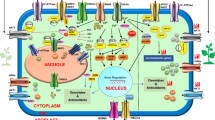Abstract
The impact of water stress was analysed in the xero-halophyte Mediterranean shrub Atriplex halimus using two Tunisian populations originating from a sub-humid coastal site (Monastir) or from a semi-arid area (Kairouan). Seedlings were exposed for 10 days to nutrient solution containing either 0 or 15% polyethylene glycol. Water potential (Ψw), osmotic potential (Ψs), osmotic potential at full turgor [Ψs(100)], relative water content (RWC), shoot dry weight (DW) and changes in solute concentrations were quantified every 2 days throughout the stress period and inorganic solutes contents were determined at the end of the treatment. The water deficit induced a decrease in Ψw, Ψs and RWC in both populations, recorded changes being higher in plants of Monastir than those of Kairouan while the shoot dry weight was reduced in a similar extent in stressed plants from both populations. Water deficit induced an increase in proline, glycinebetaine and sugar concentrations. Proline accumulated as early as after the 24-h stress treatment while, glycinebetaine required more than 6 days of stress to accumulate. At the end of the stress period, the plants of Kairouan population accumulated higher amounts of proline than those of Monastir, while an opposite trend was reported for glycinebetaine. Both populations specifically accumulated Na+ in response to drought stress, suggesting that this element could play a physiological role in the stress response of this xero-halophyte species. Presented results suggest that the non-recyclable osmotic solute glycinebetaine does not necessarily preferentially accumulates in population facing permanent water stress and that other strategy than osmotic adjustment might be involved in drought tolerance of A. halimus.





Similar content being viewed by others
References
Bajji M, Kinet JM, Lutts S (1998) Salt stress effects on roots and leaves of Atriplex halimus L. and their corresponding callus cultures. Plant Sci 137:131–142
Bates LS, Waldren RP, Teare ID (1973) Rapid determination of free proline for water-stress studies. Plant Soil 39:205–207
Bessieres MA, Gibon Y, Lefeuvre JC, Larher F (1999) A singlestep purification for glycinebetaine determination in plant extracts by isocratic HPLC. J Agr Food Chem 47:3718–3722
Cerda A, Pardines J, Botella MA, Martinez V (1995) Effect of potassium on growth, water relations, the inorganic and organic solute contents. 2. Maize cultivars grown under saline conditions. J Plant Nut 18:839–851
Colmer TD, Epstein E, Dvorack J (1995) Differential solute regulation in leaf blades of various ages in salt-sensitive wheat and salt-tolerant wheat × Lophopyrum elongatum (Host) A Löve amphiploid. Plant Physiol 108:1715–1724
Correia MJ, Pereira JS (1995) The control of leaf conductance of white lupin by xylem ABA concentration decreased with the severity of water deficits. J Exp Bot 46:101–110
Di Martino C, Delfine S, Pizzuto R, Loreto F, Fungi A (2003) Free amino acids and glycinebetaine in leaf osmoregulation of spinach responding to increasing salt stress. New Phytol 158:455–463
Girija C, Smith BN, Swamy PM (2002) Interactive effects of sodium chloride and calcium chloride on the accumulation of proline and glycinebetaine in peanut (Arachis hypogaea L.). Environ Exp Bot 47:1–10
Hanson AD, Rathinasabapathi B, Rivoal J, Burnet M, Dillon MO, Gage DA (1994) Osmoprotecttive compounds in the Plumbaginaceae: a natural experiment in metabolic engineering of stress tolerance. Proc Nat Acad Sci USA 91:306–310
Le Houérou HN (1992) The role of saltbushes (Atriplex spp.) in arid land rehabilitation in the Mediterranean Basin: a review. Agroforest Sys 18:107–148
Lefèvre I, Marchal G, Meerts P, Corréal E, Lutts S (2009) Chloride salinity reduces cadmium accumulation by the Mediterranean halophyte Atriplex halimus L. Env Exp Bot 65:142–152
Mäkelä P, Peltonen-Sainio P, Jokinen K, Pehu E, Setala H, Hinkkanen R, Somersalo S (1996) Uptake and translocation of foliar-applied glycinebetaine in crop plants. Plant Sci 21:221–230
Martínez JP, Ledent JF, Bajji M, Kinet JM, Lutts S (2003) Effect of water stress on growth, Na+ and K+ accumulation and water use efficiency in relation to osmotic adjustment in two populations of Atriplex halimus L. Plant Growth Regul 41:63–73
Martínez JP, Lutts S, Schanck A, Bajji M, Kinet JM (2004) Is osmotic adjustment required for water-stress resistance in the Mediterranean shrub Atriplex halimus L.? J Plant Physiol 161:1041–1051
Martínez JP, Kinet JM, Bajji M, Lutts S (2005) NaCl alleviates polyethylene glycol-induced water stress in the halophyte species Atriplex halimus L. J Exp Bot 56:2421–2431
McNeil SD, Nuccio ML, Hanson AD (1999) Betaines and related osmoprotectants: targets for metabolic engineering for stress tolerance. Plant Physiol 120:945–949
Ramanjulu S, Sudhakar C (2000) Proline metabolism during dehydration in two mulberry genotypes with contrasting drought tolerance. J Plant Physiol 157:81–85
Rhodes D, Hanson AD (1993) Quaternary ammonium and tertiary sulfonium compounds in higher plants. Ann Rev Plant Physiol Plant Mol Biol 44:357–384
Santa-Cruz A, Perez-Alfocea F, Caro M, Acosta M (1998) Polyamines as short-term salt tolerance traits in tomato. Plant Sci 138:9–16
Schölander PF, Hammel HT, Bradstreet ED, Hemmingsen EA (1965) Sap pressure in vascular plants. Science 148:339–346
Shen YG, Du BX, Zhang WK, Zhang JS, Chen SY (2002) AhCMO, regulated by stress in Atriplex hortensis, can improve drought tolerance in transgenic tobacco. Theor Appl Genet 105:815–821
Walker DJ, Romero P, De Hoyos A, Correal E (2008) Seasonal changes in cold tolerance, water relations and accumulation of cations and compatible solutes in Atriplex halimus L. Env Exp Bot 64:217–224
Yancey PH, Clark ME, Hand SC, Bowlus RD, Somero GN (1982) Living with water-stress: evolution of osmolyte systems. Science 217:1214–1222
Yemm EW, Willis J (1954) The estimation of carbohydrates in plant extracts by anthrone. Biochem J 57:508–514
Zhang J, Nguyen HT, Blum A (1999) Genetic analysis of osmotic adjustment in crop plants. J Exp Bot 50:291–302
Acknowledgments
The authors are grateful to Tunisian authorities for the travel grant of A. Ben Hassine.
Author information
Authors and Affiliations
Corresponding author
Additional information
Communicated by A. Kacperska-Lewak.
Rights and permissions
About this article
Cite this article
Ben Hassine, A., Bouzid, S. & Lutts, S. Does habitat of Atriplex halimus L. affect plant strategy for osmotic adjustment?. Acta Physiol Plant 32, 325–331 (2010). https://doi.org/10.1007/s11738-009-0410-4
Received:
Revised:
Accepted:
Published:
Issue Date:
DOI: https://doi.org/10.1007/s11738-009-0410-4




